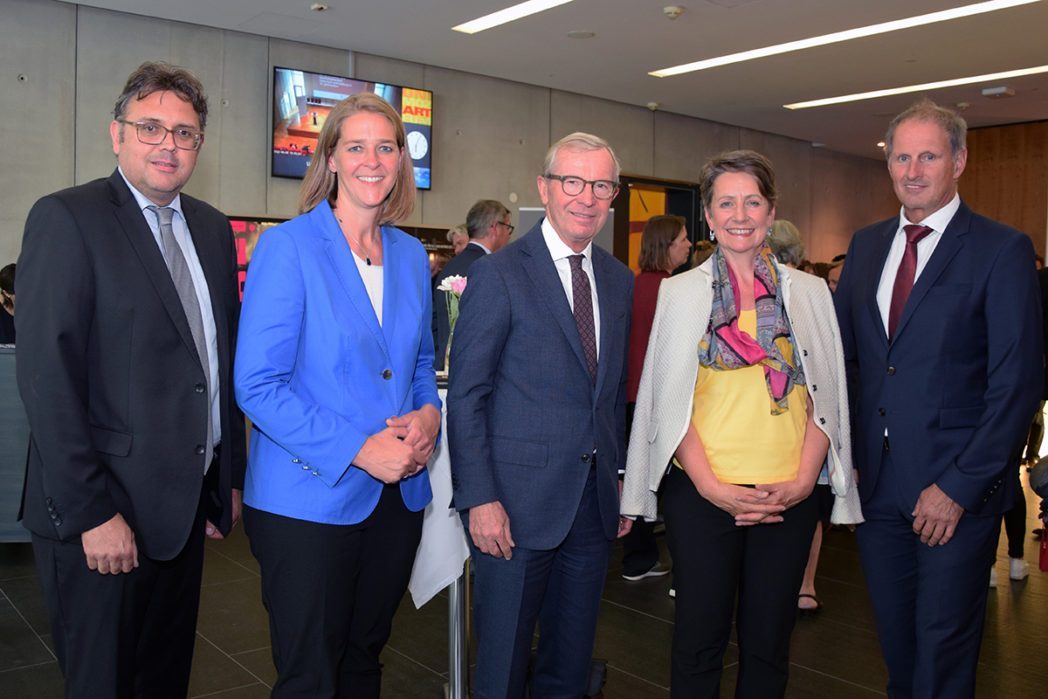
“Specialization and collaboration will be the two key words for the future,” said Governor Wilfried Haslauer and Regional Councillor Andrea Klambauer.
Prepared for 2030
Currently, the Science and Innovation Strategy Salzburg 2025 (WISS 2025) is being revised to ensure readiness for the year 2030. A significant focus in WISS 2030 will be dedicated to the university and college locations. The current path will be consistently continued, with the strategy being sharpened and adapted to new challenges.
Haslauer: “Successful Catch-up Process.”
“In recent years, Salzburg has made an impressive catch-up process in terms of research and development as a university location. WISS has contributed to profile building in teaching, research, and the economy, positioning us anew – both in relation to the federal government and now in collaboration with the federal government,” rejoiced Governor Wilfried Haslauer.
Klambauer: “Intelligent Use of the Environment.”
The Salzburg science and research location, with its six universities and colleges, Salzburg Research, the university clinic, and others, is a small but excellent location. It is important to intelligently utilize this environment. Quality, cooperation with the strongest partners, and a clear profile through specialization and niche areas where we play a leading role should give us a competitive advantage,” said Regional Councillor Andrea Klambauer during the discussion organized by Innovation Salzburg at the University Mozarteum.
Felbermayr: “Being a Leader in the Niche.”
Gabriel Felbermayr, Director of the Institute for Economic Research (WIFO), emphasized that when developing the university and research location, one must focus on “quality rather than quantity. Strengthen existing strengths and occupy niches. It’s better to be a leader in the niche than a follower in a mass market. Unique selling points should be maintained and expanded upon. Some have already understood that this is the material from which the future of Salzburg can be made.”
Herlitschka: “Universities are Beacons in the Regions.”
“Universities, colleges, and universities of applied sciences are beacons in a region and drivers for new developments,” said Sabine Herlitschka from the Council for Research and Technology Development. “Excellence is important for these institutions, international visibility, a strong connection with the regional environment, and providing impulses for developments, such as digitization.”
171 Projects Supported
Since the implementation of WISS in 2016, 171 projects with a total project volume of approximately 134 million euros have already been launched. The state of Salzburg finances around 35 percent, demonstrating a strong commitment to the importance of science, research, and innovation. Thematic focuses have included life sciences, digitization, innovation and communication technology, as well as intelligent construction and settlement systems. About 200 jobs in the research field are associated with these projects.
Source: State Correspondence
This might also interest you
6. March 2025
salz21: Necessary Steps for the Future
On March 5, 2025, salz21 | Home of Innovation once again provided a platform for future topics, innovations, and interdisciplinary exchange. More than 1,000 visitors took the opportunity to learn about current developments and discuss perspectives for tomorrow. Three topics were particularly dominant: climate protection, artificial intelligence, and a strong Europe.
6. September 2024
Franz-Benjamin Mocnik researches the communication of places.
In Salzburg, there is an exciting digitization research project: Franz-Benjamin Mocnik is studying the communication of places for the Faculty of DAS.
5. June 2024
The Faculty of Digital and Analytical Sciences after 2 years – a review
Since its establishment two years ago, the Faculty at the Paris Lodron University of Salzburg has seen significant expansion. This was also supported by the State of Salzburg and Innovation Salzburg. On Tuesday, June 4, 2024, a review was presented at a press conference.
8. March 2024
How do we shape our future?
Political and technological challenges, as well as solutions to questions about the world of tomorrow, were discussed at the well-attended Innovation and Technology Forum salz21 on March 6th at the Salzburg Exhibition Center. Let’s take a look back at the panels organized by Innovation Salzburg.